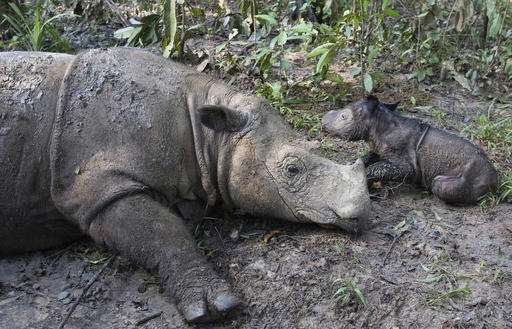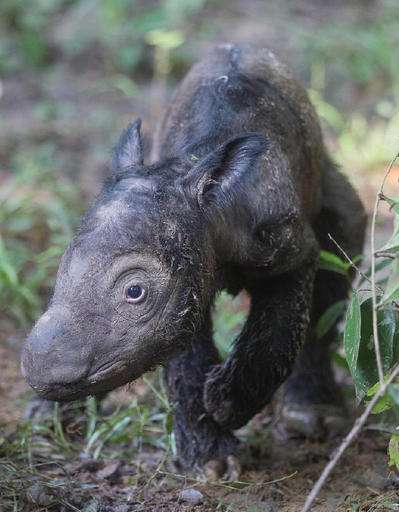In this Thursday, May 12, 2016 photo released by International Rhino Foundation (IRF), Ratu, a 14-year-old Sumatran rhinoceros, sits next to its newborn calf at Sumatran Rhino Sanctuary in Way Kambas National Park, Indonesia. Ratu has given birth at the sanctuary in a success for efforts to save the critically endangered species. (Stephen Belcher/Canon/IRF/YABI via AP)
A Sumatran rhinoceros has given birth at an Indonesian sanctuary in a success for efforts to save the critically endangered species.
The International Rhino Foundation said the female calf was born on Thursday, weighs about 45 pounds (20 kilograms) and looks healthy and active.
"We haven't stopped smiling since the moment we were sure she was alive and healthy," said IRF's executive director Susie Ellis in a statement. "While one birth does not save the species, it's one more Sumatran rhino on Earth."
Only an estimated 100 Sumatran rhinos remain, mostly on the island of Sumatra, and several are in captivity. They are threatened by destruction of tropical forest habitat and poachers who kill the animals for their horns, which are prized for making ornaments and for use in traditional medicine in China and other parts of Asia.
The species was rediscovered in the Indonesian part of Borneo through trails and footprints in 2013.
But one member of the small population on Borneo died in April after a wound from a poacher's trap became infected.
The calf is the second to its mother Ratu, who gave birth to a male named Andatu in 2012, which was the first rhino birth in captivity in Indonesia in 124 years. The father, Andalas, was born at the Cincinnati Zoo in 2001.
In this Thursday, May 12, 2016 photo released by International Rhino Foundation (IRF), a newly born Sumatran rhinoceros calf walks at the Sumatran Rhino Sanctuary in Way Kambas National Park, Indonesia. Ratu, a 14-year-old Sumatran rhinoceros has given birth to the calf at the sanctuary in a success for efforts to save the critically endangered species. (Stephen Belcher/Canon/IRF/YABI via AP)
IRF established the rhino sanctuary in the Way Kambas National Park on Sumatra in 1997. It praised the sanctuary's staff as "top-notch experts" and said the second birth shows that the expertise exists in Indonesia to increase the rhino population.
The foundation said Ratu was given a hormone supplement daily during her pregnancy to help ensure it went to full-term.
More information: rhinos.org/
© 2016 The Associated Press. All rights reserved.
























